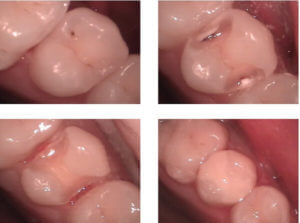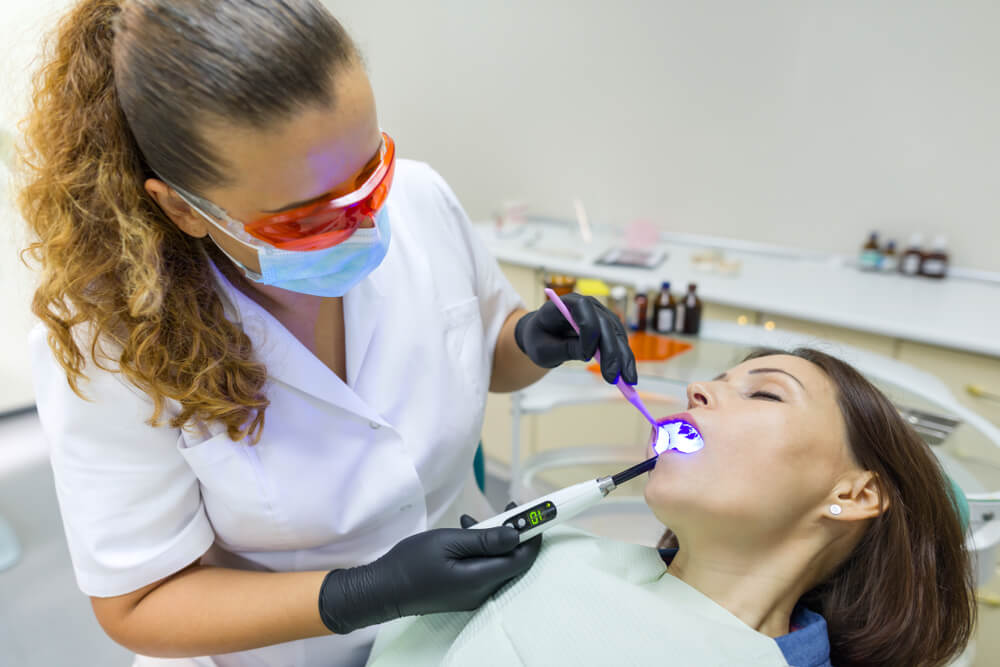Dental Bonding is a broad term that generally refers to any dental procedure which permanently attaches dental materials to a patient’s teeth using dental adhesives, and fixing them in place using high-intensity light. Composite bonding procedures also come in two forms. These are direct composite bonding and adhesive composite bonding (e.g. crowns, bridges as well as porcelain veneers). Despite their differences, however, all tooth bonding procedures share once common characteristic, and that is they are designed to restore damaged teeth back to their former beauty.
Cosmetic bonding procedures are also generally simple. They only involve putting adhesive materials (usually resin) onto the damaged area of your tooth, and then sealing them in place in order to restore the tooth’s original shape. So compared to other dental procedures, they’re actually quite simple.
All composite bonding procedures and methods fall under adhesive dentistry, which studies dental hard tissues, adhesive substances, bonding mechanisms as well as clinical techniques for bonding. From preventive dentistry to operative dentistry, tooth bonding techniques are used for all kinds of patients, with all kinds of dental problems. In fact, tooth bonding procedures are commonly used in paediatric/cosmetic dentistry, prosthodontics as well as orthodontics. So if you have a cracked or damaged tooth then dental bonding is the most convenient solution to your problem.
The Tooth Bonding Procedure
 The bonding procedure begins when your dentist uses a shade guide to choose a composite resin colour to match the colour of your teeth. After your dentist has determined the appropriate colour for your teeth, he or she will carefully abrade the surface of your tooth to prepare it for the bonding procedure. The tooth will then be coated with a small amount of adhesive liquid which is designed to help the bonding material stay on the surface of your teeth.
The bonding procedure begins when your dentist uses a shade guide to choose a composite resin colour to match the colour of your teeth. After your dentist has determined the appropriate colour for your teeth, he or she will carefully abrade the surface of your tooth to prepare it for the bonding procedure. The tooth will then be coated with a small amount of adhesive liquid which is designed to help the bonding material stay on the surface of your teeth.
Once all the preparations are complete, your dentist will then apply the composite resin onto your teeth. This resin is then moulded and smoothed until the substance complies with the shape of your teeth. The resin is then hardened using either Ultraviolet Light or a Dental Laser. After the bonding substance hardens, the next step is to trim and shape it even further. This will allow your dentist to polish the bonding material to match the natural colour of your tooth’s surface. The entire bonding process usually takes around 30 minutes to 1 hour to complete. However, if you want to have several of your teeth bonded then you will need to schedule several appointments.
After the bonding procedure is over, you will need to avoid consuming food products which can potentially stain the resin on your teeth in the next 48 hours. Food products, like tea, coffee and tobacco are good examples, so be sure to discuss this issue with your dentist when you get the chance.
What is Composite Bonding?
Composite bonding, or more specifically direct composite bonding, is a specific type of dental bonding procedure which involves the application of coloured composite resin (a special type of plastic) in order to repair any decayed, damaged or discoloured teeth in the patient’s mouth. It derives its name from the fact that its materials bond to the patient’s teeth.
Composite bonding is rightfully considered as one of the easiest and least expensive dental services in the world. In contrast to other cosmetic dental procedures, like veneers for example, bonding usually only requires a single visit. This is because the composite resin which is used in bonding can be shaped to match the damaged or fractured areas of your teeth. Furthermore, bonding is a very versatile process and can be used to address various dental problems, including a chipped tooth, teeth discolouration or closing spaces between a person’s teeth. In certain cases, bonding may also be used to alter the appearance of a patient’s teeth by making them look bigger, changing their shape or improving their colour.
It’s also worth mentioning that composite bonding procedures are relatively simple and require very little preparations. Anaesthesia, for example, is only used in bonding when the tooth that’s being bonded is damaged or decayed. Likewise, sophisticated dental equipment is rarely needed for bonding, because of the simplicity of the procedure.
How Much Does Dental Bonding Cost?
Dental bonding costs in the UK are a rather complicated issue, primarily because bonding is generally considered a cosmetic dental procedure, which is to say that it has very little effect on a person’s actual dental health.
Because of its status, bonding is not usually available on the NHS, which means that you can only get the treatment from private dentists who also perform in cosmetic dentistry.
The only exceptions are crowns and bridges, both of which fall under the category of adhesive bonding, and are considered Band 3 Treatments (you only need to pay £219). Other than these procedures, however, you’ll have a hard time convincing the NHS to cover part of your dental bill, which means that you have no choice but to go to a dental clinic in order to have the bonding procedure that you want to get.
The good news, fortunately, is that bonding is relatively cheap. Composite bonding, for example, only costs about £90 to £200, which means you can easily afford to have several of your teeth bonded. Just don’t forget to do them at even intervals, so that each tooth will be able to adapt to the procedure.
As for adhesive composite bonding procedures, it’s worth mentioning that they generally cost more than composite bonding, so you may want to save some money before you have these procedures. Crowns generally cost between £450 to £800, depending on the type of crown you want to get. As for bridges, between £400 to £1,500. Finally, porcelain veneers cost between £400 to £700.
Keep in mind that certain types of bonding may not be available at certain dental clinics, so don’t assume that your favourite dental clinic can offer the particular type of bonding procedure that you want. This is why you should compare as many options as you can before making your decision. In addition to finding a clinic that offers affordable services, looking at a wide variety of options will also help you to find a bonding procedure that is most appropriate for your dental condition.
And speaking of dental costs, it’s also worth mentioning that dental bonding procedures are not meant to treat actual dental problems, like cavities or tooth erosion. They are primarily designed to seal up cracks in your teeth and restore their original appearance, but only after the actual problem has been resolved. So be sure to get the appropriate dental treatments before you have your teeth bonded.
